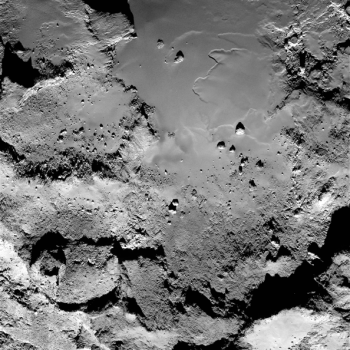The Rosetta Downlink and Archive group is pleased to announce the release of Rosetta OSIRIS images from both the wide- and narrow-angle cameras (WAC and NAC, respectively) to the Archive Image Browser and to the Planetary Science Archive.
The images cover the period 20 June 2014 – 16 September 2014, corresponding to Rosetta’s approach to the comet, arrival, and insertion into orbit.

One of the many images released today, this one showing part of the Imhotep region seen through Rosetta’s OSIRIS narrow-angle camera on 5 September 2014, from a distance of 43 km from the comet centre. Credit: ESA/Rosetta/MPS for OSIRIS Team MPS/UPD/LAM/IAA/SSO/INTA/UPM/DASP/IDA
Comparing the images from the start to the end of the period shows the incredible increase in detail as Rosetta moved from thousands of kilometres from Comet 67P/Churyumov-Gerasimenko to within just 30 km. The images and data collected in the weeks following arrival at the comet on 6 August were used to select Philae’s landing site.
Now that significant work has been done to improve the OSIRIS image processing pipeline to ensure that the submitted dataset is compatible with the archive standards, more regular releases are expected.
The next release of OSIRIS images is anticipated for late January 2016 and is planned to include data from the close observation phase – when the spacecraft was just 10 km from the comet – and from the period around comet landing.
Update 18 Dec: A short FAQ has been added to the browser to answer questions that have arisen since this release regarding, for example, the orientation of the images, and differences in format/metadata between what is provided in the browser and in the Planetary Science Archive.










Discussion: 12 comments
Oh man, we have a date for the release of the Osiris images around the landing date !
🙂
Clearly, I’ve been hating the Osiris’people for keeping for themselves the images for so long. If it does release in January, it will be 15 months vs the 6months policy.
I think the harm is done, at least on my side. I will remember those guys and where they work and will make sure to pressure my government so that they never land a contract with ESA ever.
But for now, I’ll have a smile on my face: the kidnapped pictures are coming ! Many thanks to those who made this possible.
Yipee !!!
Hi Guili,
The OSIRIS team had 12month proprietary period, not 6. Given the complexity of the data set, and the huge effort needed to deliver archive-compatible data (believe me, I have been on a few missions), I think it’s OK if they are 3 months late.
Sure, I wish we would have seen more data earlier, but honestly the NAVCAM images was already much better than any other comet mission data taken before 🙂
First time I hear about the 12 months proprietary of the Osiris team. This topic has been adressed before in the blog and 12 months was never mentionned.
Obviously, ESA’s policy of 6 months should apply to everyone on board of the Rosetta project.
Regarding the complexity, this is clearly not the reason. Let’s not cover the scientific embargo decided on these pictures behind exagerated technical reasons.
Nada que agradecer:
Todos los equipos implicados en la misión Rosetta, excepto Osiris, han ido liberando sus trabajos de manera paulatina desde hace mucho tiempo y nos hemos congratulado con ellos de sus descubrimientos.
Ahora, por fin, aparecen las fotos que hemos demandado en tantas ocasiones, pues las hemos pagado con nuestros impuestos. Sin embargo el interés que ahora despiertan es considerablemente menor al que pudo haber tenido hace un año.
Hurra por NAVCAM.
Hola Ciberia: Si jpg.de (semi tiempo real) logra ser estabilizado y expuesto globalmente, tendrá un efecto de masas equivalente a una segunda misión.
Emily
Thank you very much and thanks to OSIRIS as well. I’m especially struck by the detail of specific features in photos 7-10.
There is a small teething problem. People may have noticed this already but I’ve looked at the first ten and they are all mirror images of what they should be (I know I’m a fan of mirrored matches but you really don’t need to go this far 🙂 )
Hi Cooper. OSIRIS is a multi-filter instrument. Another teething problem is that many open source renderers declare damage at last portion of the .PNG content, truncating the rendering.
Quite a ‘gray’ object, doesn’t it? 🙂
As for ESAC issues. Could also be related to delivery limits on the servers.
Hi Andy
Please see the FAQ which has been added to help answer some of these questions arising: https://imagearchives.esac.esa.int/index.php?/page/osiris_images_qa
Best wishes,
Emily
Always sure of Teams’ Ethos. Only surprised of what expected to be a long pathway. Asking forgiveness about the smallish, but continuous, annoyances [or nuances].
Antoni Gaudí quizá el único que no se sorprendería de lo que estamos por ver.
https://en.wikipedia.org/wiki/File:Maqueta_funicular.jpg
https://es.wikipedia.org/wiki/Archivo:SF_-_interior.jpg